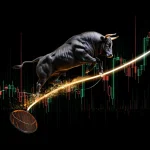
Introduction: What is Flocking behaviour?
Oct 16, 2024
Have you ever watched a flock of birds soar gracefully through the sky, seemingly moving in perfect unison? This mesmerizing phenomenon of flocking behaviour, where individuals in a group follow each other, can be observed not only in nature but also in the stock market. It raises a thought-provoking question: What happens when investors mimic the actions of their peers, and how does this collective behaviour shape market dynamics?
In today’s fast-paced financial landscape, understanding flocking behaviour is crucial for investors seeking to navigate the complexities of market sentiment. This essay delves into the intricacies of flocking behaviour, its psychological underpinnings, and how contrarian investing can yield exceptional returns by capitalizing on the herd mentality.
Understanding Flocking behaviour
Flocking behaviour refers to the tendency of individuals to align their actions or decisions with those of a group. This phenomenon is not limited to birds; it can be observed in various social contexts, including financial markets. In investing, flocking behaviour manifests as herd mentality, where investors collectively buy or sell assets based on the actions of others rather than independent analysis.
A striking statistic reveals the extent of this behaviour: during market crashes, studies show that 70% of investors tend to sell their stocks during a downturn, often exacerbating the decline. This self-reinforcing cycle of panic selling showcases the power of flocking behaviour, where fear overrides rational decision-making.
The implications of flocking behaviour are profound. When investors follow the crowd, they often overlook fundamental analysis and technical indicators, leading to market inefficiencies. The Efficient Market Hypothesis (EMH) posits that all available information is reflected in asset prices; however, flocking behaviour challenges this notion, suggesting that prices can deviate significantly from intrinsic value.
The Role of Cognitive Biases
Cognitive biases play a crucial role in flocking behaviour, influencing how investors perceive and react to market conditions. Common biases include:
1. Herd Mentality: Investors often feel compelled to follow the crowd, fearing they will miss out on gains or suffer losses if they deviate from the group. This bias can lead to irrational exuberance during bull markets and panic selling during downturns.
2. Overconfidence: Many investors overestimate their knowledge and abilities, believing they can predict market movements better than others. This overconfidence can lead to reckless decisions, particularly during periods of market volatility.
3. Recency Bias: Investors tend to give disproportionate weight to recent events, leading them to extrapolate short-term trends into the future. This bias can contribute to the formation of bubbles or crashes, as investors react to the latest news rather than considering the long-term outlook.
Understanding these cognitive biases is essential for investors seeking to break free from the constraints of flocking behaviour. By recognizing their own tendencies, investors can make more informed decisions that align with their investment strategies.
Contrarian Investing: A Path to Success
Contrarian investing is a strategy that involves going against prevailing market sentiment. This approach capitalizes on the emotional responses of the masses, allowing savvy investors to identify opportunities when others are driven by fear or greed.
Warren Buffett, one of the most successful investors of all time, famously stated, “Be fearful when others are greedy and greedy when others are fearful.” This philosophy underscores the essence of contrarian investing. When the market is engulfed in fear, prices may fall below their intrinsic value, creating buying opportunities for those willing to be bold.
One notable example of successful contrarian investing occurred during the 2008 financial crisis when many investors fled the market in panic. John Templeton, a renowned investor, saw this as an opportunity to buy undervalued stocks. His contrarian approach paid off, as he made significant profits when the market eventually recovered.
Contrarian investors often use technical analysis to identify entry and exit points. Technical indicators can help gauge market sentiment, revealing when assets are oversold or overbought. By leveraging this information, contrarians can time their moves effectively, capitalizing on market reversals.
Psychological Traps and Market behaviour
The psychological traps that investors fall into are crucial to understanding flocking behaviour and its impact on market dynamics. As mentioned earlier, herd mentality, overconfidence, and recency bias can skew market behaviour, leading to irrational price movements.
For instance, during the dot-com bubble of the late 1990s, many investors succumbed to herd mentality, pouring money into internet stocks based solely on hype and fear of missing out. When the bubble burst in 2000, those who had followed the crowd faced significant losses, while contrarian investors who had identified the market’s irrational exuberance were able to profit by shorting overvalued stocks.
The power of contrarian investing lies in its ability to exploit these psychological traps. By recognizing when the market is driven by fear or greed, contrarians can position themselves for exceptional returns. As George Soros famously noted, “It’s not whether you’re right or wrong that’s important, but how much money you make when you’re right and how much you lose when you’re wrong.”
Real-World Examples of Flocking Behaviour and Contrarian Success
To illustrate the phenomenon of flocking behaviour in the stock market and the success of contrarian investing, let’s examine a few real-world examples:
1. The GameStop Phenomenon: In early 2021, a group of retail investors on Reddit’s WallStreetBets forum banded together to buy shares of GameStop, driving the stock price to astronomical levels. This flocking behaviour was fueled by a mix of fear of missing out and a desire to challenge institutional investors. The subsequent volatility highlighted the dangers of herd mentality, as many investors faced significant losses when the stock price eventually plummeted.
2. Warren Buffett’s Coca-Cola Investment: In the late 1980s, Buffett invested heavily in Coca-Cola when the stock was out of favour due to concerns about health trends. While many investors shied away from sugary beverages, Buffett saw the brand’s intrinsic value and long-term potential. His contrarian bet paid off, as Coca-Cola’s stock price soared over the following decades.
3. Carl Icahn’s Activist Investing: Icahn is known for his contrarian approach, often targeting companies that are undervalued or poorly managed. By taking significant stakes in these companies and pushing for changes, he has successfully turned around many businesses. His willingness to go against the crowd has resulted in substantial gains, demonstrating the effectiveness of contrarian investing.
The Importance of Technical Analysis
Technical analysis is a valuable tool for contrarian investors seeking to time their moves effectively. By analyzing price patterns, volume trends, and various indicators, investors can gain insights into market sentiment and identify potential reversals.
For instance, moving averages can help smooth out price fluctuations, allowing investors to identify trends and potential entry points. Oversold and overbought indicators, such as the Relative Strength Index (RSI), can signal when an asset is due for a correction. By combining technical analysis with an understanding of flocking behaviour, contrarians can make more informed decisions.
William O’Neil, the founder of Investor’s Business Daily, developed the CAN SLIM system, which combines fundamental and technical analysis. This approach has helped many investors identify potential winners before they become widely recognized by the market.
Conclusion: Embracing Flocking Behaviour and Contrarian Investing
Flocking behaviour is a powerful force in the stock market, shaping investor decisions and influencing market dynamics. While it often leads to irrational price movements driven by fear and greed, understanding this phenomenon provides valuable insights for investors.
By recognizing the cognitive biases that contribute to flocking behaviour and embracing contrarian investing, individuals can position themselves for exceptional returns. As the financial landscape continues to evolve, the ability to think independently and challenge prevailing sentiment will remain crucial for success.
When the masses often follow the crowd, contrarian investors have the potential to uncover hidden opportunities and achieve remarkable results. By leveraging technical analysis and remaining vigilant against psychological traps, investors can navigate the complexities of the market and thrive amidst the chaos of flocking behaviour.
Words that Leave an Impression: Captivating Articles













